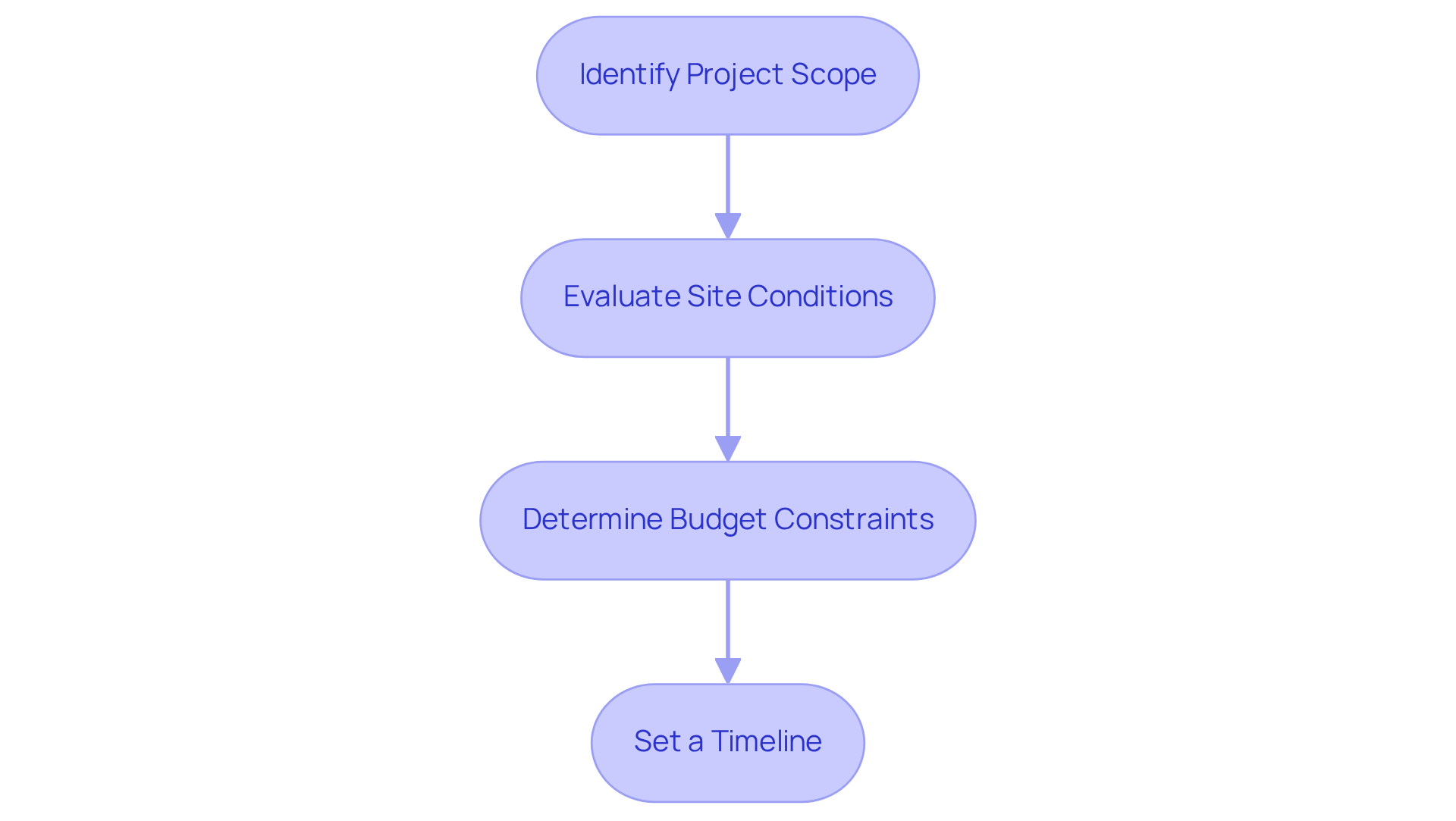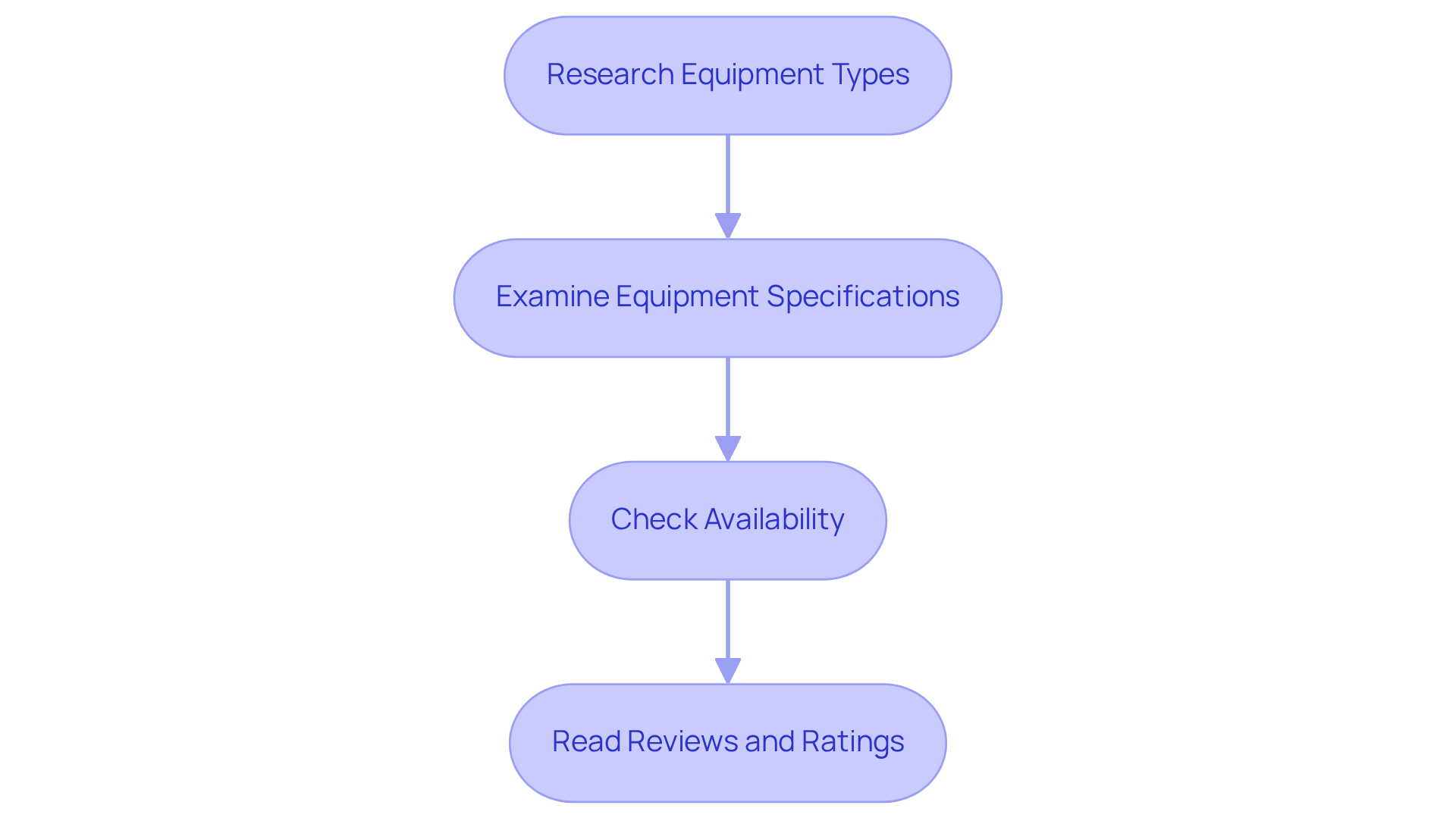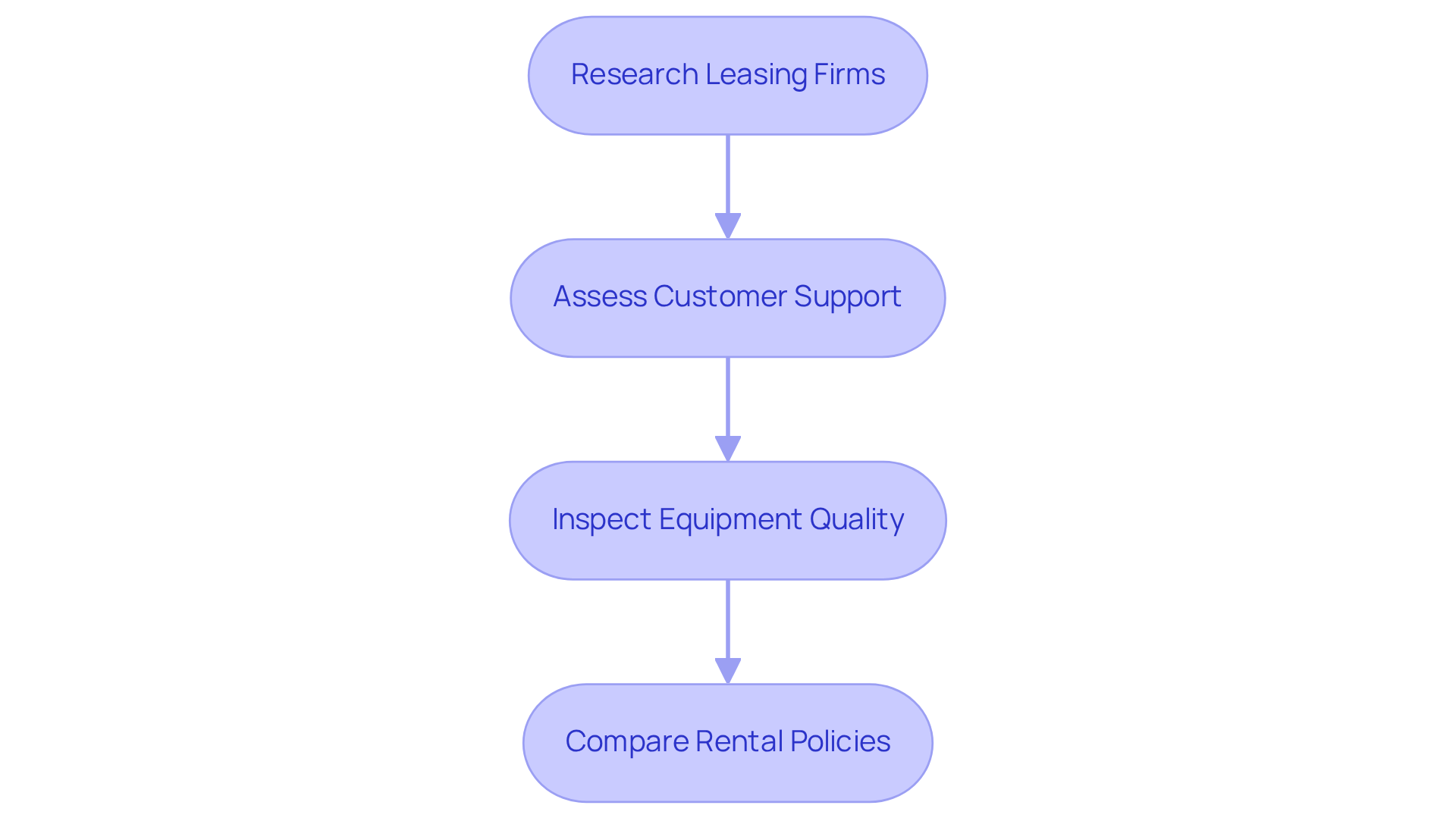Overview
The article delineates four essential steps for effective demolition tool rental management:
- Defining project requirements
- Exploring available tools
- Understanding rental terms
- Evaluating service providers
Each step underscores the critical importance of thorough planning and research. This approach not only ensures safety and adherence to budget but also facilitates optimal tool selection, thereby significantly enhancing the overall efficiency and success of demolition projects.
To begin, defining project requirements is paramount. This initial step sets the foundation for all subsequent actions, guiding the selection of tools that align with specific project needs. By clearly understanding what is required, teams can avoid unnecessary expenditures and ensure that the right equipment is on hand.
Next, exploring available tools is vital. A comprehensive assessment of the tools at one's disposal allows for informed decisions that can lead to increased productivity. Each type of equipment comes with its own set of benefits, and recognizing these can foster a more effective approach to demolition tasks.
Understanding rental terms is equally important. Familiarity with rental agreements and conditions can prevent unexpected costs and complications. Clear comprehension of these terms ensures that all parties are aligned, thus promoting a smoother rental experience.
Finally, evaluating service providers is essential to ensure reliability and quality. Partnering with reputable providers can make a significant difference in project outcomes. The right service provider not only offers quality equipment but also provides valuable support and guidance throughout the rental process. By adhering to these four steps, teams can optimize their demolition tool rental management, leading to successful project execution.
Key Highlights:
- Define the project scope by detailing structures for demolition and materials needing special handling to ensure safety and tool selection.
- Assess site conditions to identify constraints such as space and access, which helps determine safe demolition techniques.
- Establish a realistic budget that includes leasing costs, transportation, insurance, and permits to avoid unexpected expenses.
- Create a detailed timeline with milestones to manage equipment needs and ensure timely project completion.
- Research various demolition tools available for rent, including jackhammers and hydraulic breakers, to match project requirements.
- Review equipment specifications such as power and weight to select the most suitable tools for optimal performance.
- Confirm tool availability with local rental firms to streamline the rental process.
- Examine customer reviews and case studies to assess the reliability and effectiveness of demolition tools.
- Thoroughly review rental agreements to understand usage, maintenance responsibilities, and liability.
- Familiarise yourself with pricing models (hourly, daily, weekly) to align costs with the project timeline.
- Clarify additional fees like late return charges and damage waivers to prevent unexpected costs.
- Negotiate rental terms for extended leases to secure discounts and improve project management.
- Research reputable leasing firms and assess their customer support and equipment quality before finalising a lease.
Introduction
Navigating the complexities of demolition projects demands more than sheer brute force; it requires a strategic approach to managing tool rentals for success. With the escalating demand for demolition equipment, it is imperative to assess project needs meticulously, select the right tools, and manage rental agreements effectively. However, amidst the myriad options and potential pitfalls, how can one ensure they are making the optimal choices for their specific project? This guide explores four essential steps for effective demolition tool rental management, empowering project managers to optimize resources and streamline operations.
Assess Project Requirements and Constraints
- Identify Project Scope: Clearly define the scope of your demolition project by detailing which structures need to be demolished and identifying any materials that require special handling. This documentation is essential for directing your choice of tools and ensuring adherence to safety regulations. By establishing a precise project scope, you lay the groundwork for a successful demolition process.
- Evaluate Site Conditions: Conduct a thorough assessment of the site to identify constraints such as space limitations, access points, and environmental considerations. For example, a thorough assessment of the structure is crucial prior to the start of demolition work, as it aids in identifying the safest demolition techniques and the suitable tools required. Continuous site monitoring can also help identify potential hazards early, ensuring a safer work environment. This proactive approach not only safeguards your team but also enhances operational efficiency.
- Determine Budget Constraints: Establish a realistic budget for your gear leasing, taking into account not only the leasing costs but also potential additional expenses such as transportation, insurance, and any necessary permits. The typical budget for demolition tool rental initiatives can vary significantly based on the size of the project and the specific tools required, making meticulous planning essential to avoid unexpected costs. By managing your budget effectively, you can allocate resources wisely and ensure financial stability throughout the project.
- Set a Timeline: Outline a detailed timeline that includes key milestones and deadlines. This will help you determine how long you will need the equipment and whether any specific rental terms apply. Effective time management is essential for the success of an endeavor, as it enables timely completion and adherence to budget limitations. Frequently assessing financial reports can also aid in closely monitoring expenses, ensuring that the endeavor stays on course. A well-structured timeline not only keeps your project on track but also fosters accountability among your team.

Explore Available Demolition Tool Options
- Research Equipment Types: Familiarize yourself with the diverse range of demolition tool rentals available, including jackhammers, concrete saws, and hydraulic breakers. Each tool serves a specific function and is tailored for various materials, making it essential to select the appropriate one for your project requirements. Notably, the demolition tool rental sector is projected to grow from US$ 210.5 million in 2023 to US$ 380.6 million by 2033, indicating a rising demand for these resources.
- Examine Equipment Specifications: Review the specifications of each device—power, weight, and operational requirements. Understanding these details will assist you in selecting instruments that align with your project's needs and ensure optimal performance. For example, hydraulic breakers are crucial for efficient demolition in mining operations, while concrete saws excel in precise cutting tasks.
- Check Availability: Contact local leasing firms, such as EZ Equipment Rental, to confirm the availability of the demolition tool rental you require. Compile a list of preferred resources based on your research to streamline the rental process. As Josh Nickell, Vice President of the American Rental Association, emphasizes, effective planning and analytics are vital in forecasting equipment needs.
- Read Reviews and Ratings: Investigate customer feedback and evaluations of the resources you are considering. This can yield insights into their reliability and performance in real-world applications. Additionally, exploring case studies on different types of demolition tools can demonstrate their effectiveness and inform your decision-making process.

Understand Rental Terms and Pricing Structures
- Review Rental Agreements: It is imperative to thoroughly examine the rental agreements from EZ Equipment Rental. Focus on key terms related to usage, maintenance responsibilities, and liability to ensure clarity and avoid potential disputes. Comprehending these terms is essential, particularly when considering the varied assortment of tools available for demolition tool rental, such as demolition hammers and forklifts, which can significantly impact your project.
- Understand Pricing Models: Familiarize yourself with various pricing structures, including hourly, daily, or weekly rates. Assess which model aligns best with your project timeline and budget constraints. The machinery leasing market is projected to expand, with revenues expected to approach nearly $76.6 billion in 2024. Notably, the U.S. machinery leasing market size increased by $1.6 billion from 2020 to 2021, indicating a robust growth trend. Renting equipment like trailers can save you time and money, thereby enhancing overall project efficiency.
- Inquire About Additional Fees: It is crucial to clarify any potential extra charges, such as late return fees, damage waivers, or delivery costs. Being aware of these can prevent unexpected expenses at the conclusion of your lease period. As the leasing penetration index is anticipated to reach 55% in 2023, up from 53.8% in 2022, understanding these fees becomes increasingly important as reliance on leasing services grows.
- Negotiate Terms if Possible: For extended assignments, consider discussing leasing conditions with EZ Equipment Rental. Many businesses are willing to provide discounts for prolonged leases, reflecting a trend where flexibility is a key factor for contractors opting to lease equipment. This adaptability can result in significant cost savings and improved project management. As Nathan Crossley, a Rental Software Strategist, emphasizes, it is vital to continuously review your pricing structure against market trends for effective management.
Evaluate Rental Service Providers for Quality and Support
- Research Leasing Firms: Identify reputable leasing firms with a solid industry standing. Thoroughly review their websites, examine customer testimonials, and verify any industry certifications to establish their credibility.
- Assess Customer Support: Scrutinize the customer support provided by the company. Consider their availability throughout your lease term and whether they offer guidance on device usage. Effective support can significantly enhance your overall experience.
- Inspect Equipment Quality: Prior to finalizing your lease, inspect the equipment to confirm it is in optimal working condition. Inquire about maintenance records and any recent repairs to ensure reliability on the job site.
- Compare Rental Policies: Evaluate the terms related to damage, maintenance, and support of different providers. Choose a provider that aligns with your project requirements and offers favorable terms, as this can influence both your budget and project timeline.

Conclusion
Effective management of demolition tool rentals is essential for the success of any demolition project. By thoroughly assessing project requirements, exploring available tools, understanding rental terms, and evaluating service providers, one can ensure a smooth and efficient process. This structured approach minimizes risks while maximizing resource utilization and cost-effectiveness.
The article outlines four essential steps:
- Identifying the project scope and site conditions sets the foundation for tool selection.
- Researching equipment options and understanding their specifications enables informed decision-making.
- Comprehending rental agreements and pricing structures prevents unexpected costs and fosters better financial planning.
- Evaluating rental service providers ensures that the tools are reliable and supported throughout the project.
In conclusion, prioritizing effective demolition tool rental management can lead to significant improvements in project efficiency and safety. By implementing these best practices, project managers can navigate the complexities of demolition with confidence, ultimately contributing to successful project outcomes. Embracing these strategies enhances operational effectiveness and positions teams for future success in the ever-evolving landscape of construction and demolition.
Frequently Asked Questions
What is the first step in preparing for a demolition project?
The first step is to identify the project scope by clearly defining which structures need to be demolished and identifying any materials that require special handling.
Why is it important to evaluate site conditions before demolition?
Evaluating site conditions is crucial to identify constraints such as space limitations, access points, and environmental considerations, which aids in determining the safest demolition techniques and suitable tools required.
How can continuous site monitoring benefit a demolition project?
Continuous site monitoring helps identify potential hazards early, ensuring a safer work environment and enhancing operational efficiency.
What should be considered when determining budget constraints for a demolition project?
A realistic budget should include leasing costs for tools, transportation, insurance, and any necessary permits, as the budget can vary significantly based on project size and specific tool requirements.
Why is setting a timeline important for a demolition project?
Setting a timeline helps outline key milestones and deadlines, enabling effective time management, ensuring timely completion, and fostering accountability among the team.
How can financial reports assist in managing a demolition project?
Frequently assessing financial reports aids in closely monitoring expenses, ensuring that the project stays on course and within the established budget.




